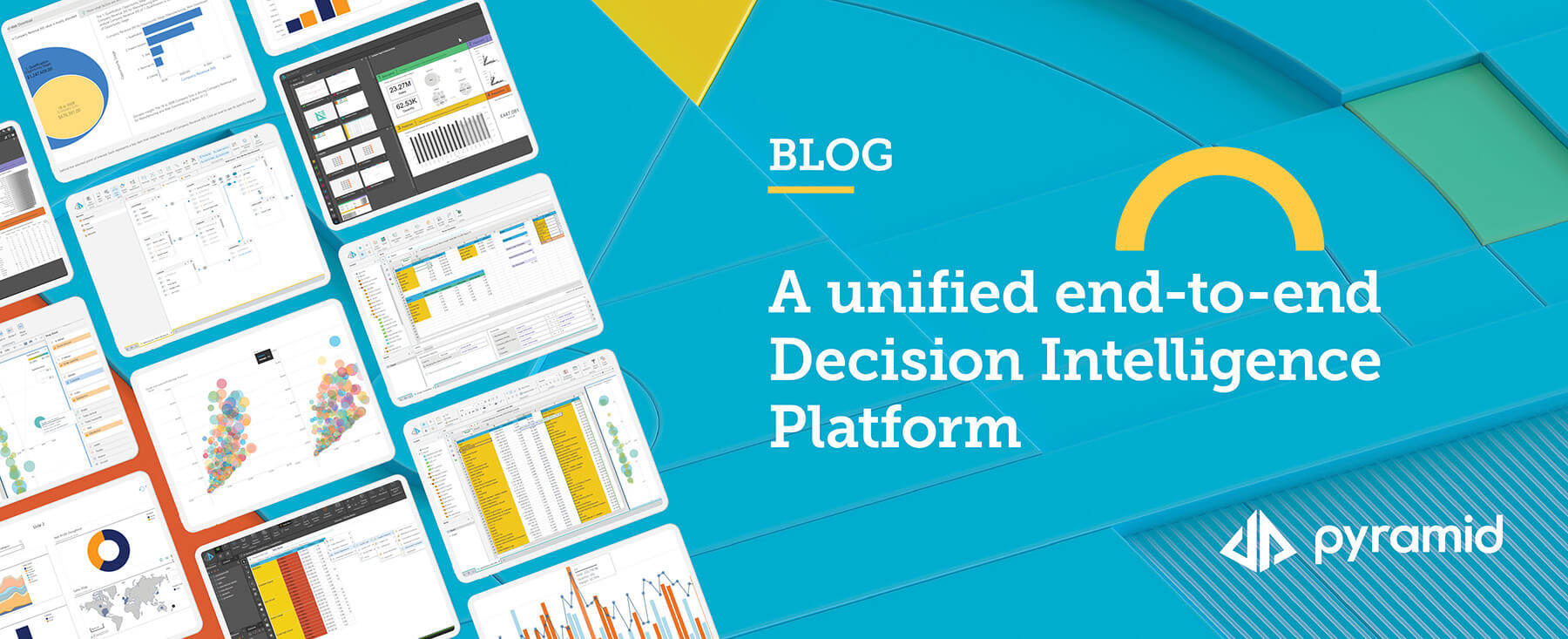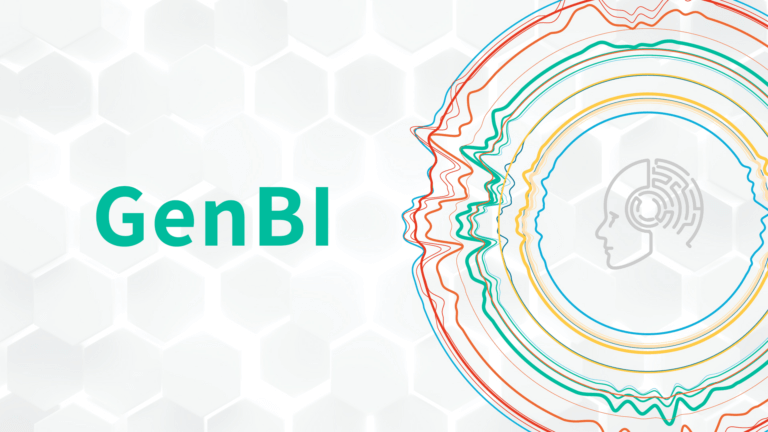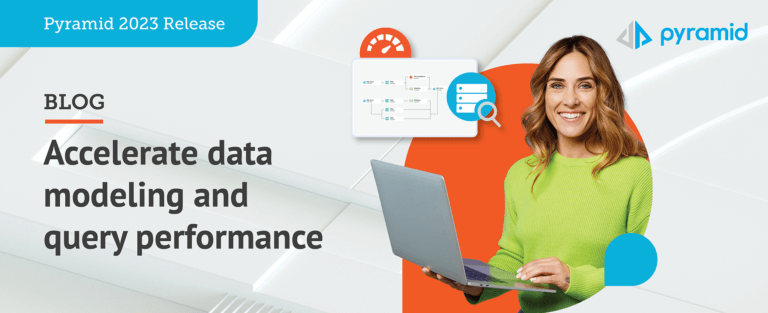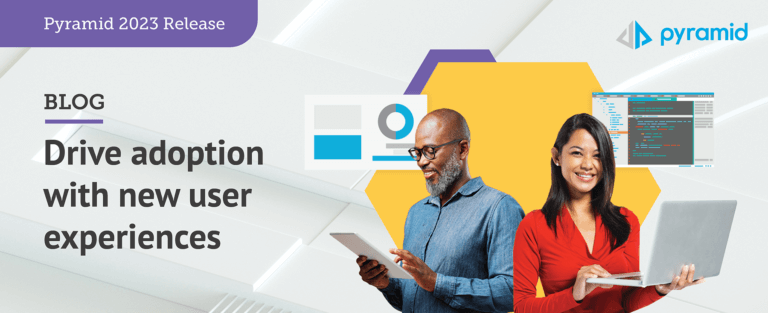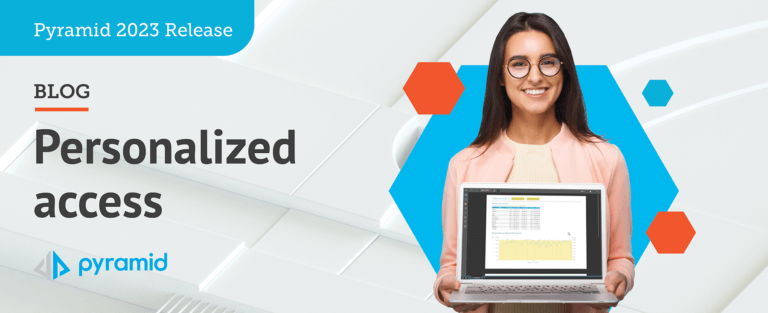We are pleased to announce the new and updated feature lineup for Pyramid 2023. This is one of our most ambitious releases yet. It is a HUGE release with more than 80 new features and capabilities that dramatically extend the power and capabilities of our platform. We introduce some game-changing generative AI capabilities as well as AI-driven features that accelerate Decision Intelligence. These new features build on prior releases and extend the “Data Factory for Decisions” – a framework that will help enterprises make better, faster decisions with data and deliver an augmented, low-code/no-code experience to help build a data-driven culture without compromising on analytical sophistication.
Here are the highlights of the release.
Tabulate and Solve for Business and Decision Modeling
For too long, analysts have been taking data out of secure, governed platforms and performing business modeling in spreadsheets, leading to the proliferation of multiple versions of the truth, often called “spreadsheet hell.” Pyramid’s Tabulate app—a browser-based spreadsheet interface—helps wrangle that problem. It’s not a replacement for spreadsheets but enables business modeling with live data right within the platform—and that’s a big deal. A huge advantage of this approach is that it remains within a single, unified platform where the connections to multiple data sources are hydrated and secure – wherever the data resides (such as in SAP BW, AWS Redshift, Snowflake, Microsoft cubes, etc.). No more proliferation of out-of-date, static spreadsheet logic with old data that no one can agree on.
Now users benefit from the combined power of a Data Factory for Decisions plus the flexible business modeling capabilities of Tabulate. Explore business scenarios, build forecasts, analyze financial and operational data, test what-if scenarios, and explore business outcomes in our new spreadsheet-like interface using a familiar library of 500 analytical, mathematical, text/string, statistical, and date and time functions.
In this release, we also added Tabulate Lite for less-technical business users so they can contribute analytic content using a “lite” interface that still delivers the sophisticated analytics you expect from Pyramid. It provides a simplified data analysis and business modeling approach through a streamlined interface that includes the most commonly used functions.
We’ve really delivered on the “decision” in “Decision Intelligence” with the addition of Solve. The Solve add-in enables decision intelligence and prescriptive analytics for complex decision modeling. Users can now move beyond descriptive, diagnostic, and predictive analysis to model their business problems. Prescriptive analysis finds optimal solutions and enables “what-if” simulations. Solve can prescribe what a decision-maker “should do” in certain situations. And we built it so that non-technical and business users can now surface machine-generated decisions and easily adjust inputs to observe changes in those decisions without having to grapple with the underlying complexities. Users benefit from Solve’s ability to help decide how to do more with less or how to use less to do more. That’s because Solve helps businesses model optimal outcomes. Whether trying to optimize revenue, profits, margins, or resources like investment dollars, inventory, or time, Solve is a perfect solution for decision modeling. Use Solve to help you understand what you should do for optimal results.
And possibly best of all, the content from both Tabulate and Solve can be dynamically embeddable and shared inside and outside your organization through dashboards and publications without needing to proliferate the underlying spreadsheets, logic, and data.
Faster Decisions with AI-driven Insights
With our OpenAI/ChatGPT integration, Pyramid has changed the game by fusing generative AI with business analytics. From within the platform, analysts can use ChatGPT prompts to source publicly available data (such as population data) to include in an analysis alongside live corporate data and then securely perform calculations on the combined data within Pyramid. This combines the best of two worlds – the power of generative AI to quickly source public data and Pyramid’s sophisticated, secure platform for analyzing corporate data. In addition, analysts can create data-driven analytic commentary combined with ChatGPT natural language narrative with live metrics and descriptions. Analysts can also enter natural language prompts to generate spreadsheet formulas, SQL, MDX code, and Python or R scripts for data science projects. Furthermore, they can automatically generate and apply data visualizations and dashboard designs.
Another new, improved AI-driven Pyramid feature, Explain the Difference, uses an AI engine so users can request a plain language narrative explaining the difference. This speeds time-to-insight by simplifying the Discover process and applying statistical techniques to ensure more accurate insights without needing technical expertise. It uses AI and ML to identify driving measures and attributes between the selected values. Users benefit from letting AI explain the difference, quickly exploring all the possible contributors and calculating their relative contribution, providing both the analysis and a natural language explanation.
Recommended Queries builds on our native Chatbot to track and recommend common queries. Manually discovering the right query to use is time-consuming and not practical. So, Pyramid is introducing a new feature, Recommended Queries, leveraging AI within the Discover and Present modules. Now, a recommender algorithm learns from other users’ queries and dynamically presents recommendations as users type in their natural language query, saving time, increasing productivity, and reducing the time to insights
In 2023, we’ve also accelerated data preparation by offering a Random Forest approach to impute missing values for statistical analysis, machine learning model training, time series forecasting, and more. Using algorithmic techniques to Fill the Blanks enables analysts to work with more robust data sets and be more productive.
Accelerate Data Modeling and Query Performance
Querying large tables, extending your data model, and adding new logical columns just got a lot faster and easier. Pyramid 2023 provides the capability to use Aggregate Tables within the semantic model to make them less compute-intensive and speed up queries. This feature enables the semantic modeler to create and mark aggregate tables for Pyramid’s PYRANA query engine to use automatically. Now with Pyramid’s PYRANA query engine, users can experience unparalleled query speeds against large data tables.
Custom Columns empower users to enhance their data models with additional measures and attributes without needing to augment the underlying database. Custom Columns are calculations that are designed to virtually append calculated values to an existing data model as new columns of data. By virtue, they are calculations that run at the grain or transactional level, so they are sometimes referred to as ‘granular’ calculations. They can be added dynamically at run time by users and shared with others through both Discover and Formulate Apps or added to the Semantic Model through the Model App.
Personalized Access
Users thrive and adoption soars when platforms can be tailored to users’ unique needs. The new Pyramid Hub gives users control of their homepage so they can tailor it to their needs and preferred content. This improves the user experience, efficiency, and productivity by putting critical content at their fingertips. Admins can also create customized views for new users to facilitate seamless onboarding to the platform as well as monitor platform usage (users, content, and data) with a new built-in usage Hub. Hub Embedding is another differentiating feature that enables customers who embed Pyramid to use the Hub framework to create their own collage of Pyramid content within the embedded solution with just a few lines of injectable code. And their end-users can also use Hub to customize their home pages for an unmatched, industry-leading embedded experience.
Personal Bookmarks give users another level of freedom to customize selections of slicers and parameters to the Present dashboards, delivering more ease of use and a tailored user experience.
Static PDF reports sometimes raise more questions than answers. This creates huge inefficiencies in decision-making, with endless back-and-forth between analysts and decision-makers. What if decision-makers could interact with the data in a PDF report? Now they can! With Pyramid’s new Link Back feature, users can generate pixel-perfect PDFs with a “link back” that enables decision-makers to interact with live data, perform further analysis, generate new content, and answer their own questions about the data directly. With one click, users can now interact with Publish reports by launching a live, interactive version of data visualizations.
Drive Adoption with New User Experiences
You can now drive adoption among all types of users and more quickly onboard non-technical users with our new “Lite” modules. In previous releases, we introduced Discover Lite and Present Lite. But we weren’t done there. With Tabulate Pro, Pro users get the full Tabulate module in Pyramid. We’ve now added Tabulate Lite. The Tabulate Lite version is suited for less technical users. It offers a streamlined way to build business models with the most commonly used functions.
Publish Lite is the latest in our wizard-driven series of easy-to-use content creation tools. This new feature is geared toward less technical users who are offered a guided experience via UI wizards to help generate professional pixel-perfect analytic narratives and publications in just minutes. Publish Lite also helps teams to align the right publishing strategies to the right content and to better manage publishing workloads.
With additional team members enabled through our line-up of Lite modules, we decided it was time to give a new user type a seat at the table. Introducing the new Analyst user type. The analyst user has access to the Lite versions of Discover, Present, and Publish (and if you use Tabulate, Tabulate Lite too). Now analytics projects can be streamlined and managed across your team by enabling Admins to assign seats more tailored to the users’ skills and project requirements.
Summary
That’s only a quick look at the new capabilities in Pyramid 2023. We introduced more than 80 enterprise-grade features and capabilities, with over 75% based on customer suggestions, reinforcing our mission to provide augmented, no-code solutions that empower non-technical users with self-service capabilities without sacrificing sophistication. These features expand our capabilities to help people make faster, better decisions with data.
Many thanks to customers for all the feedback. You inspire and drive many of our new features. Please keep the great ideas coming!
Read More. . .
Pyramid 2023 has many new capabilities. For a deeper dive into the features highlighted in this release, please see these additional write-ups:
- Tabulate and Solve
- Faster Decisions with AI-Driven Insights
- Personalized Access
- Drive adoption with new user experiences
- Accelerate data modeling and query performance




